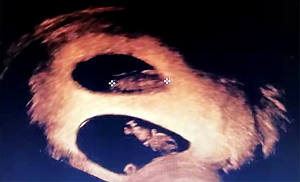Current issue
Archive
Manuscripts accepted
About the Journal
Editorial office
Editorial board
Section Editors
Abstracting and indexing
Subscription
Contact
Ethical standards and procedures
Most read articles
Instructions for authors
Article Processing Charge (APC)
Regulations of paying article processing charge (APC)
OBSTETRICS AND GYNAECOLOGY / RESEARCH PAPER
Maternal and fetal benefits of fetal reduction in triplet pregnancies
1
Xiangya Hospital Central South University, China
2
Hunan Engineering Research Center of Early Life Development and Disease Prevention, China
Submission date: 2022-11-07
Final revision date: 2023-01-08
Acceptance date: 2023-01-22
Online publication date: 2023-01-23
KEYWORDS
TOPICS
ABSTRACT
Introduction:
Triplet pregnancy is a type of high-risk pregnancy that often results in premature delivery. Although fetal reduction is recommended, a number of factors can lead to triplet pregnancies without reduction. As there is no consensus on reduction, it is necessary to carry out a specific evaluation of the benefits of reduction in triplet pregnancy. This study was performed to evaluate and discuss the prognosis of triplet pregnancy with or without fetal reduction.
Material and methods:
Clinical data from 24 women with triplet pregnancies were retrospectively collected and analyzed. Twelve women underwent fetal reduction (fetal reduction group) and 12 women continued triplet pregnancy (non-fetal reduction group). In the fetal reduction group, four dichorionic triamniotic triplets were reduced to dichorionic diamniotic twins (with a reduction of one of the monochorionic diamniotic fetuses); six trichorionic triamniotic triplets were reduced to dichorionic diamniotic twins (with a reduction of one monochorionic monoamniotic fetus).
Results:
There were significant differences in the incidence of premature rupture of membranes and neonatal hypoglycemia between the reduction and non-reduction groups. The average birth weight was significantly different between the reduction group and non-reduction group. The Apgar score was significantly different between the monochorionic monoamniotic reduction group and monochorionic diamniotic reduction group.
Conclusions:
Triplet pregnancy should be closely monitored throughout pregnancy and the perinatal period, regardless of fetal reduction. The chorionicity should be considered with fetal reduction. Compared with the mother, the remaining fetuses may benefit more from fetal reduction, especially in terms of neonatal weight.
Triplet pregnancy is a type of high-risk pregnancy that often results in premature delivery. Although fetal reduction is recommended, a number of factors can lead to triplet pregnancies without reduction. As there is no consensus on reduction, it is necessary to carry out a specific evaluation of the benefits of reduction in triplet pregnancy. This study was performed to evaluate and discuss the prognosis of triplet pregnancy with or without fetal reduction.
Material and methods:
Clinical data from 24 women with triplet pregnancies were retrospectively collected and analyzed. Twelve women underwent fetal reduction (fetal reduction group) and 12 women continued triplet pregnancy (non-fetal reduction group). In the fetal reduction group, four dichorionic triamniotic triplets were reduced to dichorionic diamniotic twins (with a reduction of one of the monochorionic diamniotic fetuses); six trichorionic triamniotic triplets were reduced to dichorionic diamniotic twins (with a reduction of one monochorionic monoamniotic fetus).
Results:
There were significant differences in the incidence of premature rupture of membranes and neonatal hypoglycemia between the reduction and non-reduction groups. The average birth weight was significantly different between the reduction group and non-reduction group. The Apgar score was significantly different between the monochorionic monoamniotic reduction group and monochorionic diamniotic reduction group.
Conclusions:
Triplet pregnancy should be closely monitored throughout pregnancy and the perinatal period, regardless of fetal reduction. The chorionicity should be considered with fetal reduction. Compared with the mother, the remaining fetuses may benefit more from fetal reduction, especially in terms of neonatal weight.
We process personal data collected when visiting the website. The function of obtaining information about users and their behavior is carried out by voluntarily entered information in forms and saving cookies in end devices. Data, including cookies, are used to provide services, improve the user experience and to analyze the traffic in accordance with the Privacy policy. Data are also collected and processed by Google Analytics tool (more).
You can change cookies settings in your browser. Restricted use of cookies in the browser configuration may affect some functionalities of the website.
You can change cookies settings in your browser. Restricted use of cookies in the browser configuration may affect some functionalities of the website.



